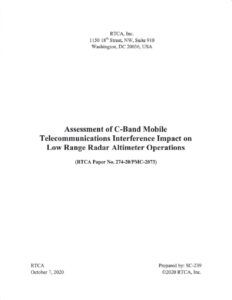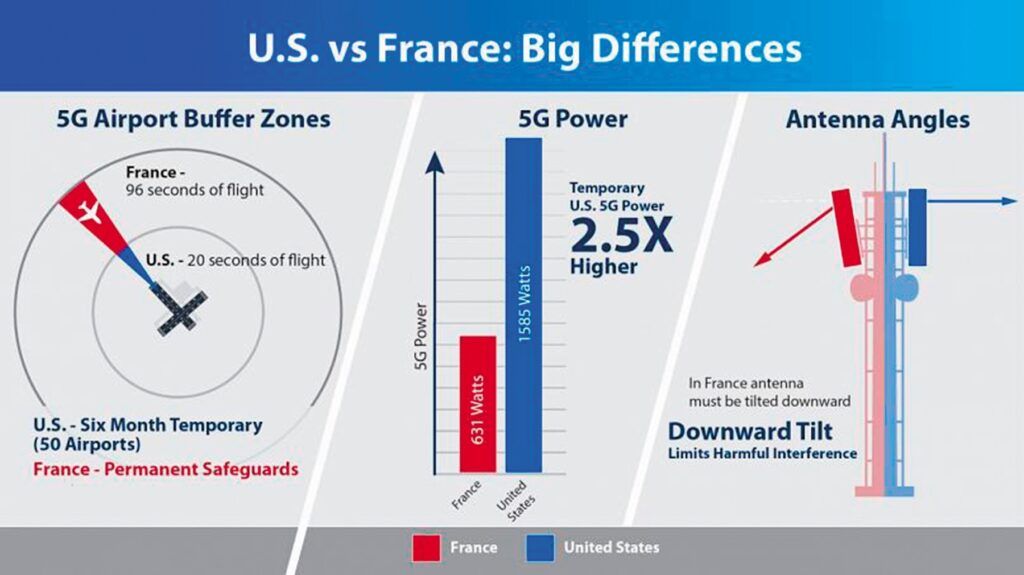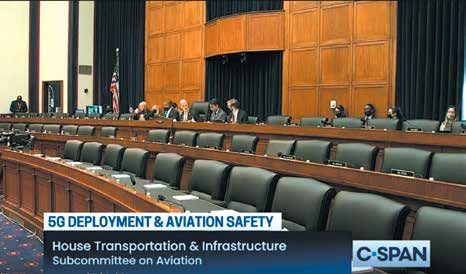Airlines and other operators have been using rad alts in safety-critical and supplemental applications for decades without having to worry about data corruption from cell phone towers. Conversely, the telecommunications industry has paid billions of dollars to acquire the rights to transmit on the assigned frequencies. In this article, we’ll discuss use of the radio-frequency spectrum. What is “spectrum?” Spectrum is nothing more than the radio frequencies that run from low Hertz (Hz) to hundreds of gigahertz (GHz). The 5G transmissions are in the lower GHz (C band) range.
As a refresher, there are radio altimeters that use a frequency modulation technique to measure distance, and radar altimeters that essentially use pulsed radar. These terms are often conflated, even by manufacturers, so we’ll just call them “rad alt.”
Let’s start with a look at the players.
FCC
The Federal Communications Commission has regulatory authority over the “airwaves.” This includes the licensing of radio operators, commercial broadcast stations, and any device that transmits a radio signal. It also allocates frequencies for specific uses. The FCC is the sole agency in the United States that has this responsibility. For example, the FCC has allocated 118 MHz to 135.975 MHz for aeronautical communications. It has set aside frequencies for commercial broadcasting, marine, police, fire, amateur radio, and public agencies. Part of its charter is to also assure that there isn’t interference between adjacent users. Since radio frequencies are used all over the world, the FCC represents the U.S. at the World Radiocommunication Conferences (WRC). Other interested parties can attend the conferences but only the FCC has the authority to vote on proposals. Through the WRC, the 118 to 135.975 MHz aeronautical communications band is “reserved” worldwide for this purpose. This is not always the case and 5G frequencies are different in different parts of the world.
Frequency allocation is just one of the duties of the FCC. However, when a frequency band is requested that will only benefit one or a few companies who will make money from using that frequency band the FCC adopted a bidding process. The telecommunications industry has thus bid billions of dollars to secure frequencies they needed for cell phone use. The 5G bidding was fierce. AT&T and Verizon got the frequencies closest to the rad-alt band, 3.7 GHz to 3.98 GHz. Sprint/T Mobile’s 5G frequencies are further away in the 3.45 to 3.55 GHz band. (Rad alts operate in the 4.2 GHz to 4.4 GHz band).
FAA
Reading this, you obviously know the functions of the FAA. What you may not know is the FAA depends on industry support in adopting new avionics requirements. Several organizations support this effort. SAE International has committees devoted to aviation matters. ASTM likewise has joint FAA/industry committees to work on aviation issues. ARINC produces standards for airline equipment. Probably the largest group that the FAA depends on is the Radio Technical Commission for Aeronautics (RTCA). It is made up of avionics company representatives from such companies as Collins, Garmin, Honeywell, and others. In addition, there will be airframe manufacturers such as Airbus, Boeing, Gulfstream, Textron, and others.
FAA depends on industry support in adopting new avionics requirements. Several organizations support this effort. SAE International has committees devoted to aviation matters. ASTM likewise has joint FAA/industry committees to work on aviation issues. ARINC produces standards for airline equipment. Probably the largest group that the FAA depends on is the Radio Technical Commission for Aeronautics (RTCA). It is made up of avionics company representatives from such companies as Collins, Garmin, Honeywell, and others. In addition, there will be airframe manufacturers such as Airbus, Boeing, Gulfstream, Textron, and others.
Finally, there are FAA representatives and trade groups such as ALPA, AOPA, and ATA. RTCA has many different subcommittees that work on different products. The subcommittee members meet periodically at RTCA’s headquarters in Washington but do most of the work remotely at their normal places of business. The subcommittee working on the 5G issue and the rad alt is SC-239. The subcommittees usually work on developing a Minimum Operational Standard for the product. Once it has received the final blessing from the RTCA it will go to the FAA for its approval and publication as a TSO (Technical Standard Order). For the rad alt, the latest TSO is C-87a which was released in 2012. Its predecessor, TSO-87 was released in 1966. It is quite an old standard and at the time there were no specific requirements regarding interference susceptibility.
NTIA
NTIA, the National Telecommunications and Information Administration is part of the Department of Commerce. It is an Executive Branch agency primarily responsible for advising the President on telecommunications and information policy. NTIA’s programs and policymaking focus largely on expanding broadband Internet access. There is a subgroup of NTIA, the Office of Spectrum Management (OSM) that is dedicated to protecting the vital federal government operations that use spectrum while also supporting the growth of commercial wireless broadband. NTIA is the designated arbitrator or referee between the FCC, FAA, and other federal agencies such as the DOD in spectrum allocation and utilization issues. This includes the 5G/rad alt issue.
Interagency Warfare
The RTCA, with the FAA’s support, released a report in October 2020 that warned of interference from 5G transmitters operating in the 3.7 to 3.98 GHz band. The report was 231 pages in length and included testing done by the Aerospace Vehicle Systems Institute (AVSI) at Texas A&M University. In recent Congressional testimony, the FAA administrator said the FAA had raised concerns about 5G interference as early as 2015. The ALPA representative said they had also voiced concerns as far back as 2018.
On the FCC side, they stated that they felt a 220 MHz guard band was adequate to ensure there would not be interference between the cell towers and rad alts. The RTCA and FAA said a 220 MHz guard band was not adequate, but the FCC disagreed and went ahead and auctioned the 3.7 to 3.98 band in December 2020. In addition to doing a dismal job at being an arbitrator, NTIA appears to have been delinquent in sharing information from the FAA and other sources with the FCC.
AT&T and Verizon spent almost 70 billion dollars for access rights. All together 81 billion dollars was spent in the 5G auctions. After the auctions, neither the FCC nor the FAA “blinked.” Once AT&T announced its intent to go live with their 5G transmissions in January 2022 the FAA issued the 5G NOTAMs that safety-critical equipment utilizing rad alt could not be used. That limited airlines to normal Category I approaches with 0.5-mile visibility. Potential safety concerns caught the attention of the national media.
Congressional Hearing
On February 3, 2022, the House Committee on Transportation and Infrastructure held a hearing on “Finding the Right Frequency: 5G Deployment & Aviation Safety.“ Besides statements by Congressional Representatives, representatives from several trade groups gave testimony. The general tone from the Congressional Representatives was one of disappointment and anger that the FCC, FAA, and NTIA didn’t work out a solution that would have avoided the last-minute restrictions on landings in low-visibility conditions. Steve Dickson, the FAA Administrator was at the hearing, but his counterpart from the FCC, Chairwoman Jessica Rosenworcel, had a scheduling conflict and was absent. Consequently, no FCC representatives were present. Congressman Peter DeFazio (D-OR) is the chairman of the Committee, but Congressman Rick Larsen (D-WA) led this subcommittee meeting.
There were fireworks, such as when chairman DeFazio said the FCC has a pattern of ignoring consequences beyond the profitability of the telecom industry. Besides the 5G/rad alt issue he mentioned two other cases where the FCC disregarded appeals for mitigating actions in other spectrum issues. He said the FCC’s only focus is the telecom industry.
He also unloaded on Meredith Baker the CTIA wireless industry spokesperson when she said that the 5G transmission power was higher in Europe than in the US. Congressman DeFazio also chastised Dennis Roberson, consultant to the FCC, after he had criticized the RTCA report. Mr. Roberson said the RTCA report used worst-case conditions, which are improbable. The Congressman pointed out that the Boeing 737 Max accidents were also improbable events that took 346 lives. Paraphrasing ALPA’s representative, Captain Joe DePete, who said in effect: “It can ruin your day if 5G interference causes the rad alt(s) to provide erroneous altitude to the autothrottle which prematurely retards the thrust levers to idle.”
On the other hand, Congressman Thomas Massie (R-KY) asked if the FAA couldn’t free up some of the current aviation spectrum to allow more public (telecom) use. He made a point that the spectrum we have now is all we will have in the future. We aren’t generating any more frequencies. He said the 4.2 to 4.4 GHz aviation band was worth $60 billion. It appeared Representative Jesus Garcia (D-IL) caught CTIA off guard when he asked if the telecom industry had set up a fund to handle the liability if 5G caused an airline crash. He also asked if the telecons would be willing to cover the cost of retrofitting rad alts in the affected aircraft.
Lots of Stink
While it did not come up in the hearing, the aviation community had previously made the point, “Hey we were here first and why should we have to change our equipment to accommodate the newcomers (5G telecommunications)?” My analogy is the feedlot operator way out on the edge of town that has been fattening and selling cattle for years. A new developer decides to build houses adjacent to the feedlot. The new homeowners tell the farmer he has to take care of the stink. Who was there first? The farmer says that he has the county commissioners (FAA) on his side and the homeowners say they have the city council (FCC) on they’re side. There will be arguments and lawsuits on who is going to pay to clean up the stink.

The View Ahead
A limited compromise was reached when the telecommunication companies agreed to provide buffer zones within approximately two miles of the airports. These are temporary with a six-month expiration date. With the buffer zones, the FAA approved alternate means of compliance (AMOC) for many aircraft including most Boeing and Airbus models, and some others. The AMOCs are specific to the radio altimeter models installed in the aircraft and are specified for individual airport approach procedures. The latest information is available via the FAA’s website under “5G and Aviation Safety.”
It is unlikely the FCC will increase the guard band that would require taking back some of the higher frequencies in the 3.7 to 3.98 GHz band. The FAA has been testing rad alts for interference and so far, approved 20 different models. Additionally, the FAA is using its flight inspection aircraft to record “real world” interference levels to determine if there can be some accommodation or if the situation is dire. When everything is said and done, older rad alts, and perhaps even some newer models, will have to tighten up their “front end” filtering. When the older rad alts were designed there was no need for a sharp cut-off, but today there is. Also, RTCA is working on new Minimum Operational Performance Standards which are likely to be released to the FAA by the end of 2022. Normally this would only apply to new rad alts. The impact of the departure of Steve Dickson, the FAA Administrator, is unknown.
Why Only In the U.S.?
This is where it gets difficult to know who is telling the truth. The aviation side says the reason Europe doesn’t have a problem is that: 1. Europe has a two-nautical mile prohibited area around the airport; 2. The 5G transmitter power is less; 3. There is a larger guard band to keep the 5G transmitters away from rad alts; 4. The 5G antennas are tilted downward. On the other hand, the telecommunications industry has taken out an internet advertisement (CTIA—5G and Airline Safety) saying Europe isn’t having a problem. The advertisement also stated that Europe has a higher 5G transmitter power and less protection around the airports. Directly opposite claim. They have also said that nearly forty other countries have rolled out 5G services without any reported interference to aviation equipment.
The internet is a great place to get more in-depth information. The RTCA had a webinar on the 5G interference issue that can be found at “RTCA Technical Webinar: Interference Risk on Radar Altimeters from Planned 5G Telecommunication.” Also, the Congressional Subcommittee Hearing “Finding the Right Frequency: 5G Deployment & Aviation Safety” is available online through CSPAN. CTIA’s ad can be found as “5G and Airline Safety.”
Now retired, Bob Teter was a CFI and avionics engineer. Years ago, he was a member of the RTCA subcommittee working on area navigation specifications. He is also a lifetime member of the American Angus Association and is thus quite familiar with BS.





